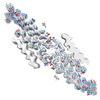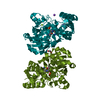[English] 日本語
 Yorodumi
Yorodumi- EMDB-21501: Amyloid-beta(1-40) fibril derived from Alzheimer's disease cortic... -
+ Open data
Open data
- Basic information
Basic information
| Entry | Database: EMDB / ID: EMD-21501 | |||||||||
|---|---|---|---|---|---|---|---|---|---|---|
| Title | Amyloid-beta(1-40) fibril derived from Alzheimer's disease cortical tissue | |||||||||
 Map data Map data | CryoEM density map from RELION-based analysis | |||||||||
 Sample Sample |
| |||||||||
 Keywords Keywords | amyloid-beta / Alzheimer's disease / PROTEIN FIBRIL | |||||||||
| Function / homology |  Function and homology information Function and homology informationamyloid-beta complex / growth cone lamellipodium / cellular response to norepinephrine stimulus / growth cone filopodium / microglia development / collateral sprouting in absence of injury / Formyl peptide receptors bind formyl peptides and many other ligands / axo-dendritic transport / regulation of Wnt signaling pathway / regulation of synapse structure or activity ...amyloid-beta complex / growth cone lamellipodium / cellular response to norepinephrine stimulus / growth cone filopodium / microglia development / collateral sprouting in absence of injury / Formyl peptide receptors bind formyl peptides and many other ligands / axo-dendritic transport / regulation of Wnt signaling pathway / regulation of synapse structure or activity / axon midline choice point recognition / astrocyte activation involved in immune response / NMDA selective glutamate receptor signaling pathway / regulation of spontaneous synaptic transmission / mating behavior / growth factor receptor binding / peptidase activator activity / Golgi-associated vesicle / PTB domain binding / positive regulation of amyloid fibril formation / Insertion of tail-anchored proteins into the endoplasmic reticulum membrane / astrocyte projection / Lysosome Vesicle Biogenesis / neuron remodeling / Deregulated CDK5 triggers multiple neurodegenerative pathways in Alzheimer's disease models / nuclear envelope lumen / dendrite development / positive regulation of protein metabolic process / TRAF6 mediated NF-kB activation / signaling receptor activator activity / Advanced glycosylation endproduct receptor signaling / negative regulation of long-term synaptic potentiation / modulation of excitatory postsynaptic potential / The NLRP3 inflammasome / main axon / transition metal ion binding / intracellular copper ion homeostasis / regulation of multicellular organism growth / ECM proteoglycans / regulation of presynapse assembly / positive regulation of T cell migration / neuronal dense core vesicle / Purinergic signaling in leishmaniasis infection / positive regulation of chemokine production / cellular response to manganese ion / Notch signaling pathway / clathrin-coated pit / extracellular matrix organization / neuron projection maintenance / astrocyte activation / ionotropic glutamate receptor signaling pathway / Mitochondrial protein degradation / positive regulation of calcium-mediated signaling / positive regulation of mitotic cell cycle / axonogenesis / protein serine/threonine kinase binding / response to interleukin-1 / platelet alpha granule lumen / cellular response to copper ion / cellular response to cAMP / positive regulation of glycolytic process / central nervous system development / positive regulation of interleukin-1 beta production / dendritic shaft / endosome lumen / trans-Golgi network membrane / positive regulation of long-term synaptic potentiation / adult locomotory behavior / learning / positive regulation of JNK cascade / Post-translational protein phosphorylation / locomotory behavior / serine-type endopeptidase inhibitor activity / microglial cell activation / positive regulation of non-canonical NF-kappaB signal transduction / TAK1-dependent IKK and NF-kappa-B activation / cellular response to nerve growth factor stimulus / regulation of long-term neuronal synaptic plasticity / recycling endosome / synapse organization / visual learning / response to lead ion / positive regulation of interleukin-6 production / Golgi lumen / cognition / Regulation of Insulin-like Growth Factor (IGF) transport and uptake by Insulin-like Growth Factor Binding Proteins (IGFBPs) / endocytosis / cellular response to amyloid-beta / neuron projection development / positive regulation of inflammatory response / positive regulation of tumor necrosis factor production / Platelet degranulation / heparin binding / regulation of translation / regulation of gene expression / early endosome membrane / G alpha (i) signalling events / perikaryon / G alpha (q) signalling events / dendritic spine Similarity search - Function | |||||||||
| Biological species |  Homo sapiens (human) Homo sapiens (human) | |||||||||
| Method | helical reconstruction / cryo EM / Resolution: 2.77 Å | |||||||||
 Authors Authors | Ghosh U / Thurber KR | |||||||||
 Citation Citation |  Journal: Proc Natl Acad Sci U S A / Year: 2021 Journal: Proc Natl Acad Sci U S A / Year: 2021Title: Molecular structure of a prevalent amyloid-β fibril polymorph from Alzheimer's disease brain tissue. Authors: Ujjayini Ghosh / Kent R Thurber / Wai-Ming Yau / Robert Tycko /  Abstract: Amyloid-β (Aβ) fibrils exhibit self-propagating, molecular-level polymorphisms that may contribute to variations in clinical and pathological characteristics of Alzheimer's disease (AD). We report ...Amyloid-β (Aβ) fibrils exhibit self-propagating, molecular-level polymorphisms that may contribute to variations in clinical and pathological characteristics of Alzheimer's disease (AD). We report the molecular structure of a specific fibril polymorph, formed by 40-residue Aβ peptides (Aβ40), that is derived from cortical tissue of an AD patient by seeded fibril growth. The structure is determined from cryogenic electron microscopy (cryoEM) images, supplemented by mass-per-length (MPL) measurements and solid-state NMR (ssNMR) data. Previous ssNMR studies with multiple AD patients had identified this polymorph as the most prevalent brain-derived Aβ40 fibril polymorph from typical AD patients. The structure, which has 2.8-Å resolution according to standard criteria, differs qualitatively from all previously described Aβ fibril structures, both in its molecular conformations and its organization of cross-β subunits. Unique features include twofold screw symmetry about the fibril growth axis, despite an MPL value that indicates three Aβ40 molecules per 4.8-Å β-sheet spacing, a four-layered architecture, and fully extended conformations for molecules in the central two cross-β layers. The cryoEM density, ssNMR data, and MPL data are consistent with β-hairpin conformations for molecules in the outer cross-β layers. Knowledge of this brain-derived fibril structure may contribute to the development of structure-specific amyloid imaging agents and aggregation inhibitors with greater diagnostic and therapeutic utility. | |||||||||
| History |
|
- Structure visualization
Structure visualization
| Movie |
 Movie viewer Movie viewer |
|---|---|
| Structure viewer | EM map:  SurfView SurfView Molmil Molmil Jmol/JSmol Jmol/JSmol |
| Supplemental images |
- Downloads & links
Downloads & links
-EMDB archive
| Map data |  emd_21501.map.gz emd_21501.map.gz | 224.1 MB |  EMDB map data format EMDB map data format | |
|---|---|---|---|---|
| Header (meta data) |  emd-21501-v30.xml emd-21501-v30.xml emd-21501.xml emd-21501.xml | 14.3 KB 14.3 KB | Display Display |  EMDB header EMDB header |
| FSC (resolution estimation) |  emd_21501_fsc.xml emd_21501_fsc.xml | 14.1 KB | Display |  FSC data file FSC data file |
| Images |  emd_21501.png emd_21501.png | 120.4 KB | ||
| Masks |  emd_21501_msk_1.map emd_21501_msk_1.map | 244.1 MB |  Mask map Mask map | |
| Filedesc metadata |  emd-21501.cif.gz emd-21501.cif.gz | 6.1 KB | ||
| Archive directory |  http://ftp.pdbj.org/pub/emdb/structures/EMD-21501 http://ftp.pdbj.org/pub/emdb/structures/EMD-21501 ftp://ftp.pdbj.org/pub/emdb/structures/EMD-21501 ftp://ftp.pdbj.org/pub/emdb/structures/EMD-21501 | HTTPS FTP |
-Related structure data
| Related structure data |  6w0oMC M: atomic model generated by this map C: citing same article ( |
|---|---|
| Similar structure data |
- Links
Links
| EMDB pages |  EMDB (EBI/PDBe) / EMDB (EBI/PDBe) /  EMDataResource EMDataResource |
|---|---|
| Related items in Molecule of the Month |
- Map
Map
| File |  Download / File: emd_21501.map.gz / Format: CCP4 / Size: 244.1 MB / Type: IMAGE STORED AS FLOATING POINT NUMBER (4 BYTES) Download / File: emd_21501.map.gz / Format: CCP4 / Size: 244.1 MB / Type: IMAGE STORED AS FLOATING POINT NUMBER (4 BYTES) | ||||||||||||||||||||||||||||||||||||||||||||||||||||||||||||||||||||
|---|---|---|---|---|---|---|---|---|---|---|---|---|---|---|---|---|---|---|---|---|---|---|---|---|---|---|---|---|---|---|---|---|---|---|---|---|---|---|---|---|---|---|---|---|---|---|---|---|---|---|---|---|---|---|---|---|---|---|---|---|---|---|---|---|---|---|---|---|---|
| Annotation | CryoEM density map from RELION-based analysis | ||||||||||||||||||||||||||||||||||||||||||||||||||||||||||||||||||||
| Projections & slices | Image control
Images are generated by Spider. | ||||||||||||||||||||||||||||||||||||||||||||||||||||||||||||||||||||
| Voxel size | X=Y=Z: 1.08 Å | ||||||||||||||||||||||||||||||||||||||||||||||||||||||||||||||||||||
| Density |
| ||||||||||||||||||||||||||||||||||||||||||||||||||||||||||||||||||||
| Symmetry | Space group: 1 | ||||||||||||||||||||||||||||||||||||||||||||||||||||||||||||||||||||
| Details | EMDB XML:
CCP4 map header:
| ||||||||||||||||||||||||||||||||||||||||||||||||||||||||||||||||||||
-Supplemental data
-Mask #1
| File |  emd_21501_msk_1.map emd_21501_msk_1.map | ||||||||||||
|---|---|---|---|---|---|---|---|---|---|---|---|---|---|
| Projections & Slices |
| ||||||||||||
| Density Histograms |
- Sample components
Sample components
-Entire : amyloid-beta(1-40) fibrils derived from human AD brain
| Entire | Name: amyloid-beta(1-40) fibrils derived from human AD brain |
|---|---|
| Components |
|
-Supramolecule #1: amyloid-beta(1-40) fibrils derived from human AD brain
| Supramolecule | Name: amyloid-beta(1-40) fibrils derived from human AD brain type: complex / ID: 1 / Parent: 0 / Macromolecule list: all Details: Fibrils produced by seeded growth using amyloid-beta in brain extract as the source of seeds. CryoEM and solid state NMR measurements were performed on second-generation seeded fibrils. |
|---|---|
| Source (natural) | Organism:  Homo sapiens (human) Homo sapiens (human) |
| Molecular weight | Theoretical: 29 kDa/nm |
-Macromolecule #1: Amyloid-beta precursor protein
| Macromolecule | Name: Amyloid-beta precursor protein / type: protein_or_peptide / ID: 1 / Number of copies: 6 / Enantiomer: LEVO |
|---|---|
| Source (natural) | Organism:  Homo sapiens (human) Homo sapiens (human) |
| Molecular weight | Theoretical: 4.335852 KDa |
| Sequence | String: DAEFRHDSGY EVHHQKLVFF AEDVGSNKGA IIGLMVGGVV UniProtKB: Amyloid-beta precursor protein |
-Experimental details
-Structure determination
| Method | cryo EM |
|---|---|
 Processing Processing | helical reconstruction |
| Aggregation state | filament |
- Sample preparation
Sample preparation
| Concentration | 0.45 mg/mL |
|---|---|
| Buffer | pH: 7.4 / Component - Concentration: 10.0 mM / Component - Formula: Na2HPO4/NaH2PO4 / Component - Name: Phosphate buffer Details: 10 mM phosphate buffer with 0.01% NaN3 to avoid microbial contamination. Buffers were filtered to avoid contamination. |
| Grid | Model: Quantifoil R1.2/1.3 / Material: GOLD / Mesh: 300 / Support film - topology: HOLEY / Pretreatment - Type: GLOW DISCHARGE / Pretreatment - Time: 60 sec. / Pretreatment - Atmosphere: OTHER / Pretreatment - Pressure: 0.036000000000000004 kPa / Details: The grids were checked in microscope prior to use. |
| Vitrification | Cryogen name: ETHANE / Chamber humidity: 90 % / Chamber temperature: 293 K / Instrument: LEICA PLUNGER Details: The grids were preblotted for 10 seconds and blotted for 6 seconds before plunging.. |
| Details | Protein exists in solution as amyloid fibrils of varying lengths. |
- Electron microscopy
Electron microscopy
| Microscope | TFS KRIOS |
|---|---|
| Alignment procedure | Coma free - Residual tilt: 6.0 mrad |
| Specialist optics | Energy filter - Name: GIF Quantum LS / Energy filter - Slit width: 20 eV |
| Details | Preliminary grid screening was done manually in FEI T12. |
| Image recording | Film or detector model: GATAN K2 QUANTUM (4k x 4k) / Detector mode: SUPER-RESOLUTION / Digitization - Frames/image: 1-50 / Number grids imaged: 1 / Number real images: 1337 / Average exposure time: 10.0 sec. / Average electron dose: 73.5 e/Å2 |
| Electron beam | Acceleration voltage: 300 kV / Electron source:  FIELD EMISSION GUN FIELD EMISSION GUN |
| Electron optics | C2 aperture diameter: 100.0 µm / Illumination mode: FLOOD BEAM / Imaging mode: BRIGHT FIELD / Cs: 2.7 mm / Nominal defocus max: -3.0 µm / Nominal defocus min: -0.5 µm / Nominal magnification: 130000 |
| Sample stage | Specimen holder model: FEI TITAN KRIOS AUTOGRID HOLDER / Cooling holder cryogen: NITROGEN |
| Experimental equipment |  Model: Titan Krios / Image courtesy: FEI Company |
+ Image processing
Image processing
-Atomic model buiding 1
| Details | Xplor-NIH was used to combine EM density with phi/psi restraints from NMR chemical shifts (from Talos-N Version 4.21 Rev 2016.343.11.31). |
|---|---|
| Refinement | Space: REAL / Protocol: AB INITIO MODEL |
| Output model |  PDB-6w0o: |
 Movie
Movie Controller
Controller





















 Z (Sec.)
Z (Sec.) Y (Row.)
Y (Row.) X (Col.)
X (Col.)






























